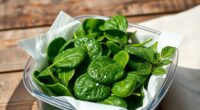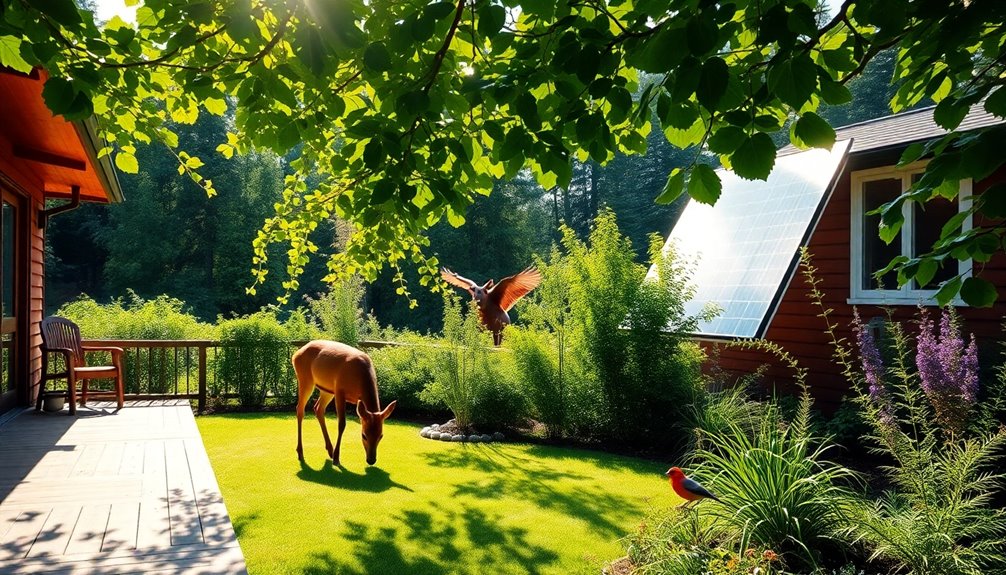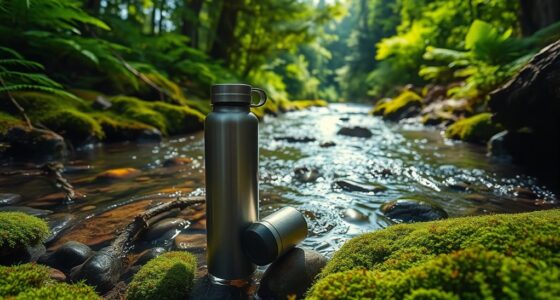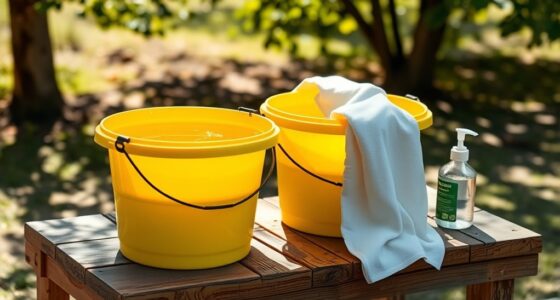To filter water in the wilderness, you can create a DIY filter using a clean plastic bottle. Cut off the bottom and make a small hole in the cap. Layer materials like cloth, sand, gravel, and activated charcoal inside. This setup helps remove impurities. For added safety, consider boiling your water or using chemical treatments like iodine tablets. It's vital to ensure your drinking water is safe, and there are more techniques to learn.
Key Takeaways
- Start by gathering materials like a clean plastic bottle, sand, gravel, activated charcoal, and cloth for your DIY water filter.
- Cut the bottom off a plastic bottle, poke a drainage hole in the cap, and layer the filtering materials inside.
- Arrange the layers with fine cloth, grass clippings, fine sand, coarse sand or pebbles, and gravel, securing with cloth in between.
- Place the filter over a clean container to collect the filtered water, testing it with dirty water to ensure effectiveness.
- Consider using chemical purifiers like iodine or chlorine tablets as an additional step for enhanced safety against microorganisms.
Understanding the Importance of Water Purification

When you're out in the wilderness, understanding the importance of water purification becomes essential for your survival.
Waterborne illnesses like giardia and dysentery can strike quickly, turning a fun adventure into a life-threatening situation. If you're traveling to remote areas, untreated water poses a serious risk. Dehydration can set in fast, causing dizziness, headaches, and nausea, making survival even harder. Clean drinking water is your top priority.
Thankfully, various purification methods, such as filtration, chemical treatments, and UV light, can help ensure your safety. Remember, untreated water can harbor harmful microorganisms, so always be proactive about purifying your water sources.
Boiling Water for Safety
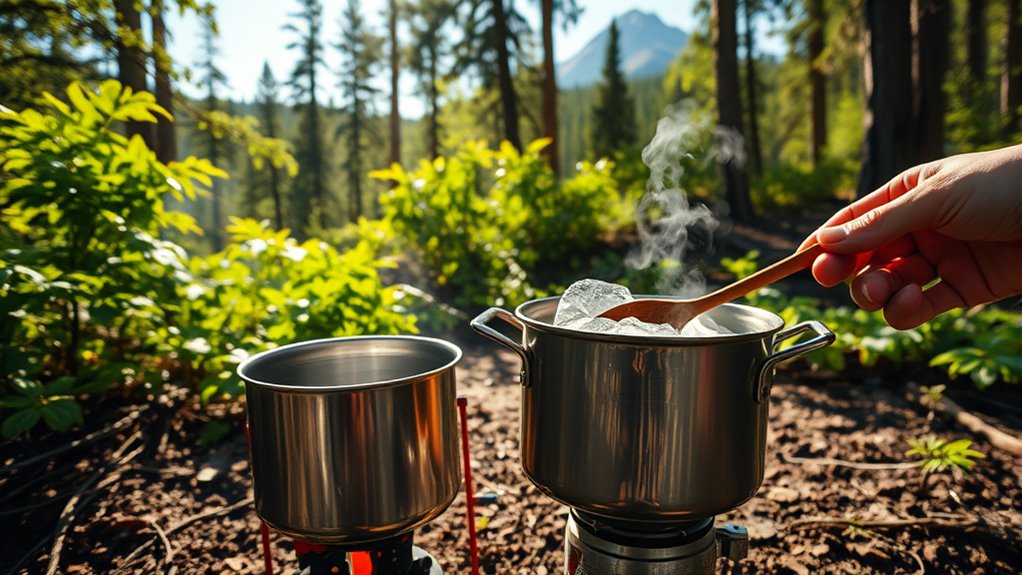
Boiling water is one of the most reliable methods to ensure your drinking supply is safe from harmful microorganisms. It effectively kills bacteria, viruses, and protozoa.
To make water safe, bring it to a rolling boil for at least one minute, or three minutes if you're above 6,500 feet. You'll need a heat source like a camping stove or campfire and a durable container, preferably stainless steel or aluminum.
Before boiling, check the water's clarity; if it's cloudy, let it settle or filter it first. Always use heat-resistant gloves and keep a fire extinguisher handy.
After boiling, let the water cool naturally before storing it in clean, sanitized containers, ensuring it's safe for consumption.
DIY Water Filters: Materials You Need
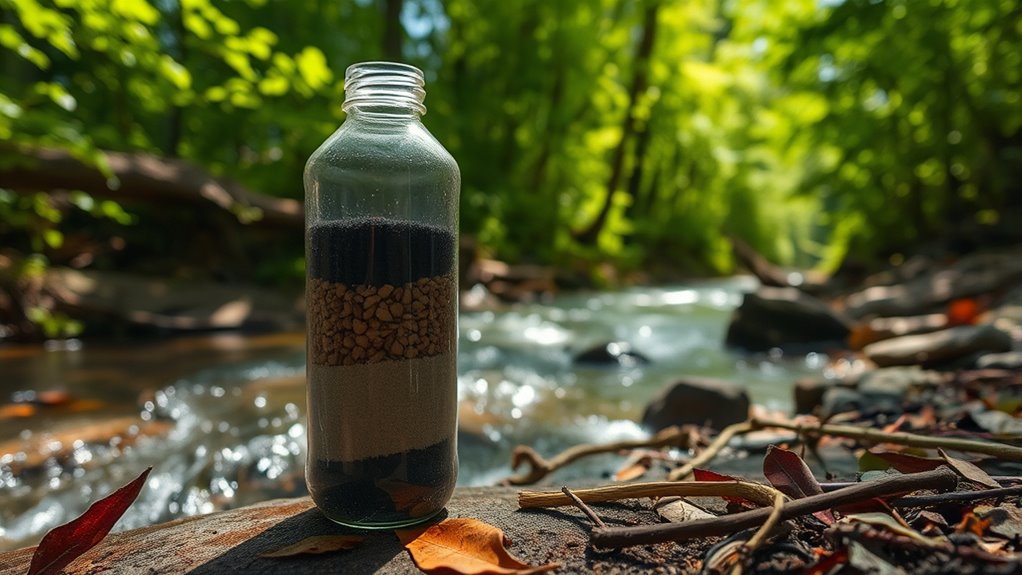
Creating a DIY water filter requires just a few essential materials that you can often find around you. Start with plastic containers like bottles or cans to form the base.
For filtering media, gather sand, gravel, and activated charcoal; these will help remove impurities effectively. You'll also need cloth or fabric, such as cotton, bandanas, or even socks, to hold the filtering materials in place.
Don't forget tools like a knife or X-ACTO blade for cutting your containers. If you're in a pinch, consider using natural materials like birch bark or large leaves.
With these supplies, you're well on your way to building a functional water filter for your wilderness adventures!
Step-by-Step Guide to Building a DIY Water Filter
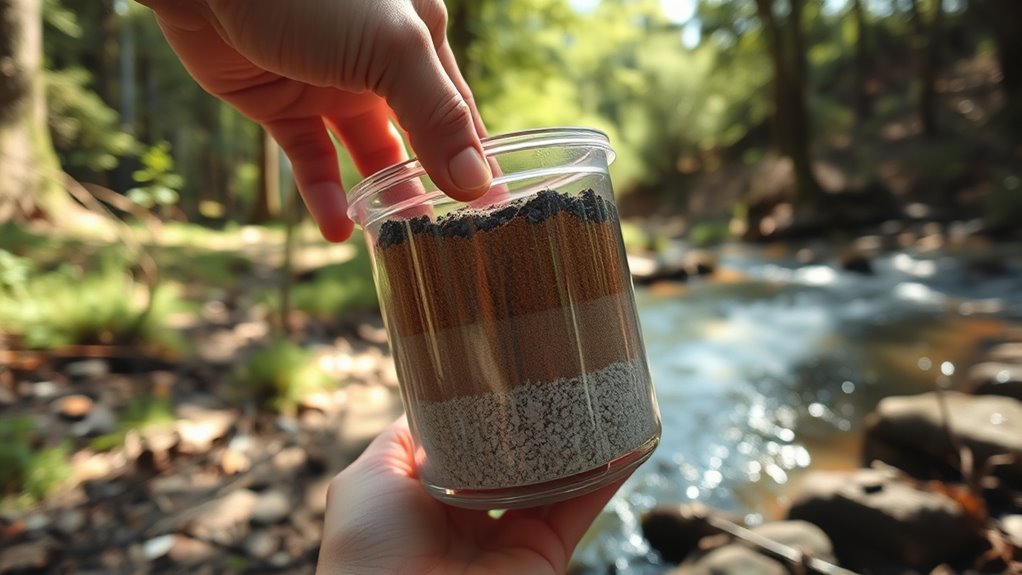
Building a DIY water filter can be a straightforward process that equips you with a vital survival tool.
Start by using a clean plastic bottle or food-grade container. Cut off the bottom to create a funnel and poke a small drainage hole in the cap.
Begin with a clean plastic bottle, cutting off the bottom to form a funnel, and make a small drainage hole in the cap.
Next, layer your filter materials: begin with fine cloth or paper, followed by grass clippings for initial filtration. Add fine sand, then coarse sand or small pebbles, and finish with gravel.
Assemble the layers in the container, using cloth between them to hold everything in place. Cover the top with porous cloth and position a second container underneath to collect the filtered water.
Test the filter with dirty water and maintain it regularly for best results.
Using Charcoal for Water Filtration
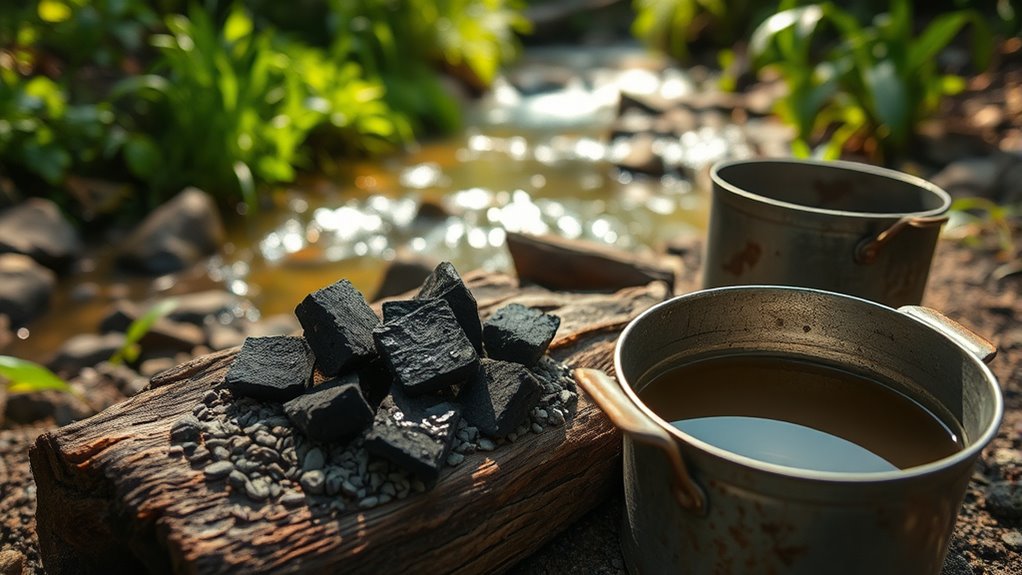
After setting up your DIY water filter, consider incorporating charcoal for enhanced purification.
Charcoal, especially when crushed into smaller particles, effectively adsorbs chemicals and toxins, improving the taste of your water. You can use either regular or activated charcoal, though activated is more effective due to its increased surface area.
Layer charcoal with pebbles and sand in your filter to maximize efficiency. Remember to use cloth as a pre-filter to keep charcoal from entering the water.
While charcoal helps remove some pathogens, it's not foolproof, so boiling the water afterward is essential for safety.
Always ensure your charcoal is free from ash to avoid contamination and maintain your filter regularly for the best results.
Chemical Purification Methods in the Wilderness
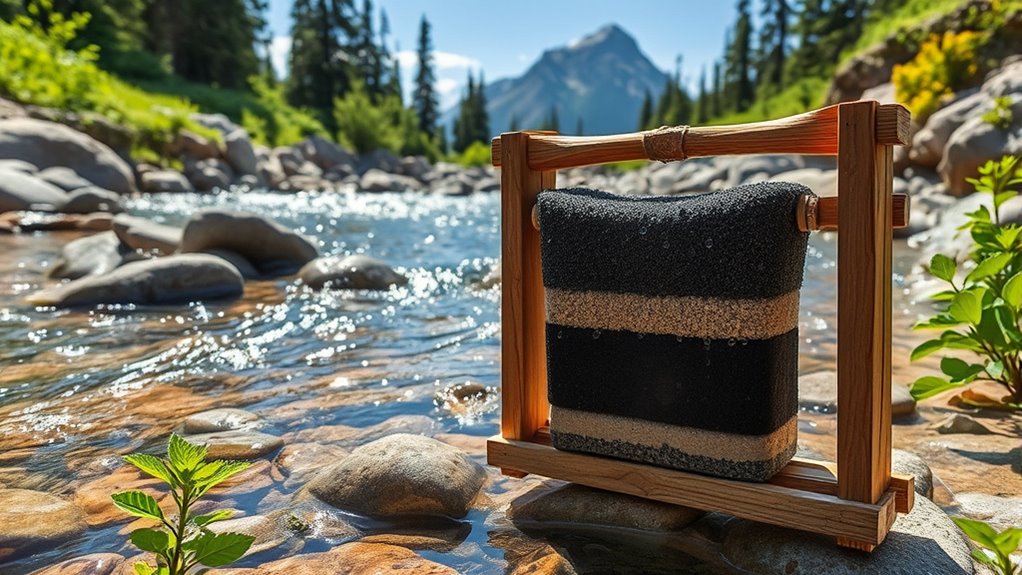
When you're in the wilderness and need safe drinking water, chemical purification methods can be a quick and effective solution. Iodine tablets and chlorine tablets are popular choices, both effective against bacteria and viruses.
Iodine typically requires about 20 minutes to work, while chlorine may leave a noticeable taste. Always follow the dosage instructions on the packaging for optimal results.
Iodine takes around 20 minutes to purify, while chlorine may impart a distinct taste; always adhere to dosage guidelines for best outcomes.
If you're sensitive to iodine or have thyroid issues, consider alternatives like UV light or boiling. Remember, while chemical methods are convenient, they mightn't eliminate all contaminants.
Use them responsibly to minimize environmental impact, and store chemicals safely to prevent accidents. Combining chemical purifiers with other methods can enhance your water safety in the wilderness.
Natural Purification Techniques You Can Try

While you may find yourself far from modern conveniences, natural purification techniques can help ensure you have safe drinking water in the wilderness.
Start by using sand and pebbles to filter out larger particles, then improve taste with charcoal made from a cooled campfire. A cloth or T-shirt can serve as a pre-filter to catch debris.
For added safety, consider using moss or certain antimicrobial plants like Oregon Grape. Boiling your water for at least five minutes is a reliable method to kill harmful microorganisms.
If you have time, let water sit to allow sedimentation. Remember, these methods enhance clarity but may not remove all contaminants, so stay cautious in your choices.
Advanced Filtration Techniques for Enhanced Safety

Natural purification techniques can provide a good foundation for ensuring safe drinking water, but advanced filtration techniques take your efforts to the next level.
Start by implementing multi-stage filtration, using different filters in series to capture a range of contaminants. Follow this with chemical purification methods like iodine tablets or chlorine to eliminate pathogens.
Implement multi-stage filtration with various filters, then use iodine or chlorine to ensure pathogen elimination.
UV treatment is another effective option, as passing filtered water through UV light destroys bacteria and viruses. Additionally, consider using activated charcoal to improve taste and remove chemicals.
DIY filters can incorporate layers of materials like sand and gravel, while pump-action filters speed up the process.
Always test your water for safety and keep clean materials separate to prevent cross-contamination.
Wilderness Survival Tips for Water Sourcing

How can you ensure a reliable water source in the wilderness? Start by identifying streams, rivers, and lakes, but remember to purify them before drinking.
Rainwater is usually safe, so collect it using containers or plastic sheeting. If you find snow or ice, melt it first.
Look for lush vegetation, as it often indicates groundwater; dig in low-lying areas or dried riverbeds to access it. Animal tracks can also lead you to water sources.
Use plants like cacti or banana trees for extra hydration. Create a solar still with plastic sheeting to collect moisture.
Always store water in clean containers and purify natural sources unless they're rainwater or snowmelt to ensure safety.
Frequently Asked Questions
Can I Use River Water for Filtration?
You can use river water for filtration, but it's crucial to remember that filtration alone isn't enough.
River water often contains harmful bacteria and viruses. Start by collecting water from higher elevations to reduce contamination.
Use materials like sand, pebbles, and charcoal to filter out larger particles.
After filtering, always purify the water through boiling or chemical disinfection to ensure it's safe to drink.
Stay cautious and prioritize your health!
How Long Does a DIY Filter Last?
Think of your DIY filter as a garden; with care, it flourishes, but neglect leads to decay.
Generally, a DIY filter lasts a few weeks to a couple of months, depending on usage and maintenance. If you clean it regularly and replace materials like charcoal, you can extend its life.
Just remember, poor-quality water and frequent use can shorten its lifespan, so keep an eye on its performance and adjust accordingly.
What if I Have No Charcoal Available?
If you don't have charcoal available, don't worry! You can improvise with materials like pebbles, sand, and cloth.
Start by cutting the bottom off a plastic bottle and layering these materials inside. You can also use natural options like bamboo or hollow logs.
Just make sure to filter the water multiple times for better clarity.
Finally, always boil the water afterward to ensure it's safe to drink.
Are There Any Plants to Avoid for Purification?
Think of your water source as a fragile ecosystem, where the wrong plant can be a poison apple.
You should avoid poisonous plants like poison ivy and sumac, as well as invasive species like Japanese knotweed. Unknown or allergenic plants can complicate your efforts, too.
Stick to safe options, because using the wrong plant could turn your quest for clean water into a risky gamble.
Stay informed to ensure your water remains pure and safe.
How Can I Tell if Water Is Safe to Drink?
To tell if water's safe to drink, observe the surroundings.
Look for vegetation and animal activity, which indicate nearby water sources. Avoid stagnant water—opt for fast-flowing streams instead.
Check for signs of pollution, like dead animals or trash. Remember, clear water can still be contaminated, so trust your instincts.
Always boil or filter the water before drinking to eliminate harmful microorganisms, regardless of its appearance.
Safety first!
Conclusion
In the wilderness, water is life, so don't take chances with what you drink. By mastering these DIY filtration techniques, you're not just quenching your thirst—you're ensuring your survival. Whether you're boiling, building a filter, or using natural methods, remember that clean water keeps you healthy and alert. So gear up, stay informed, and embrace the adventure, knowing you've got the skills to transform murky water into a refreshing life source!


